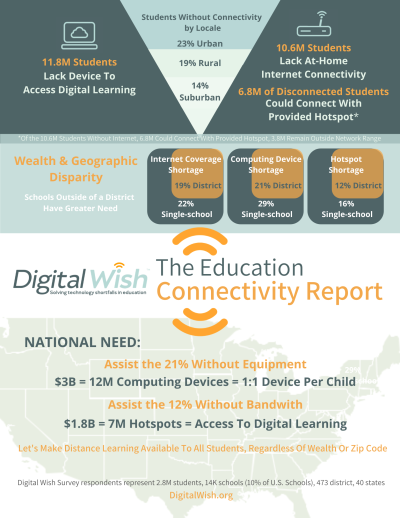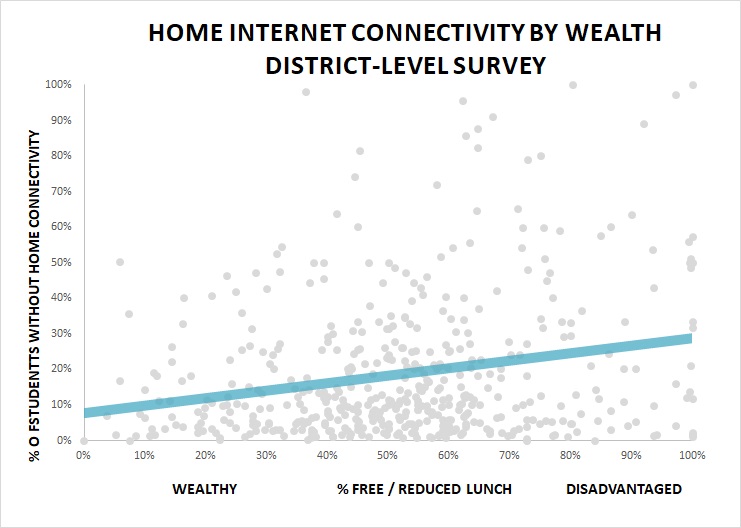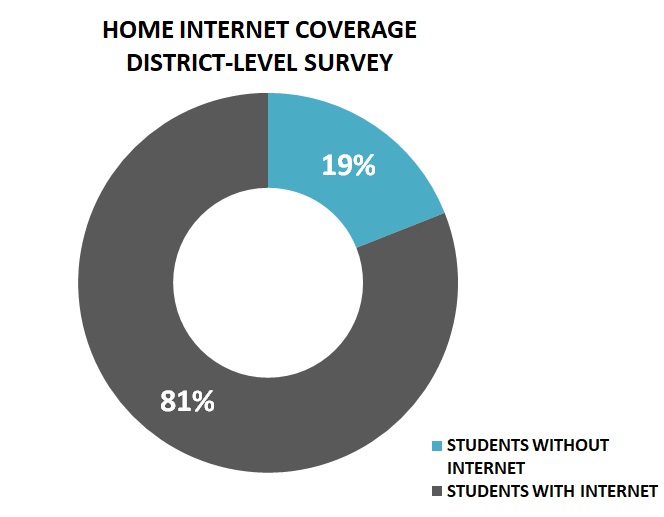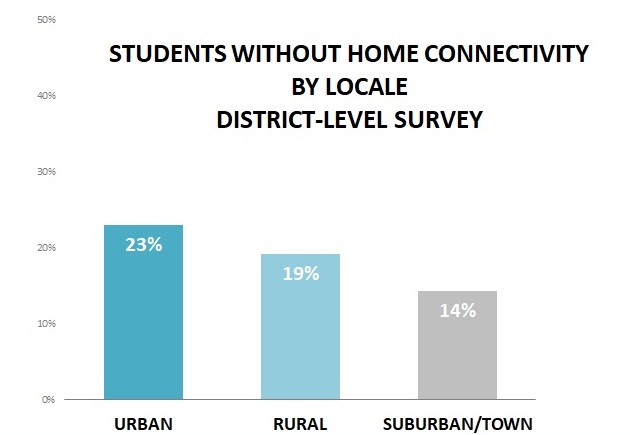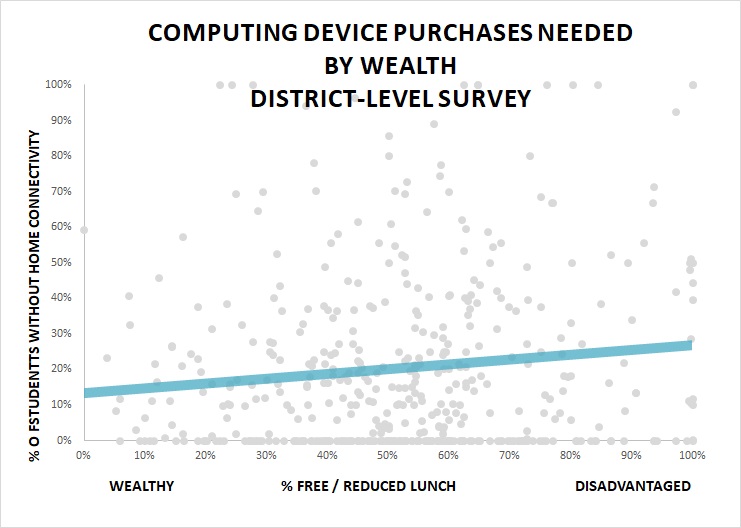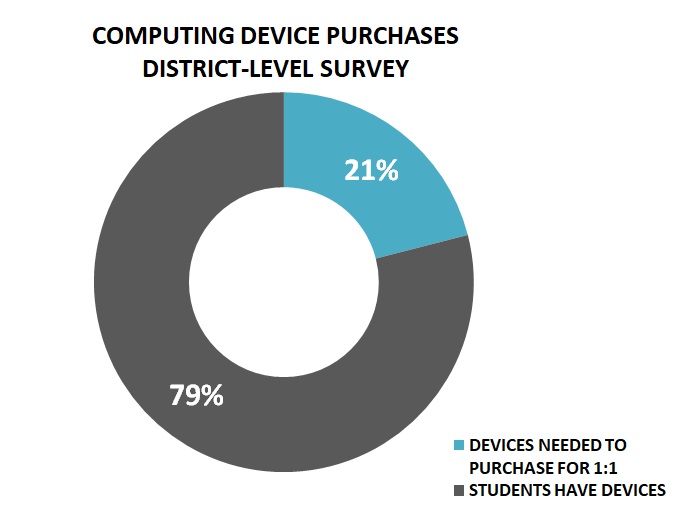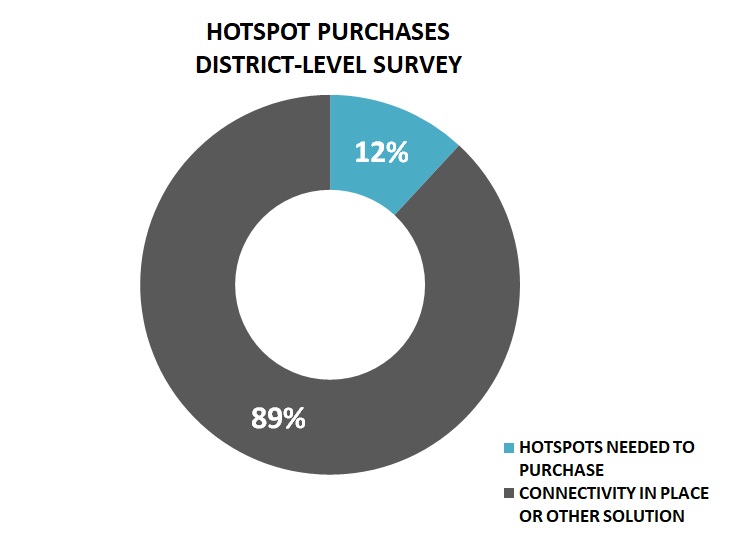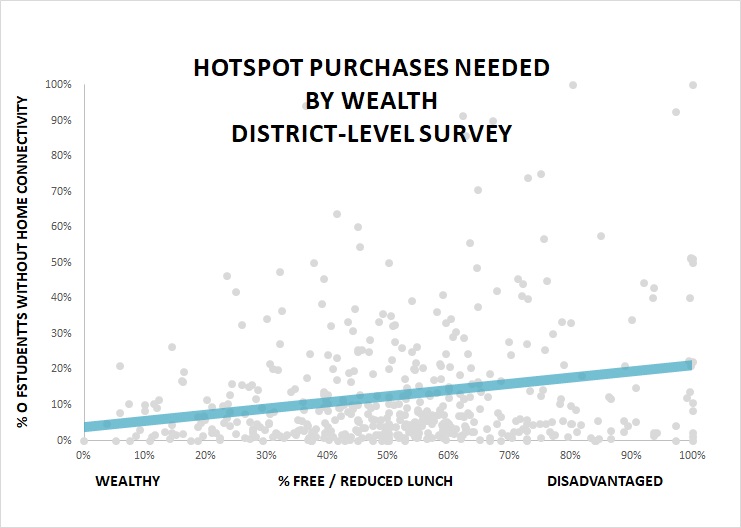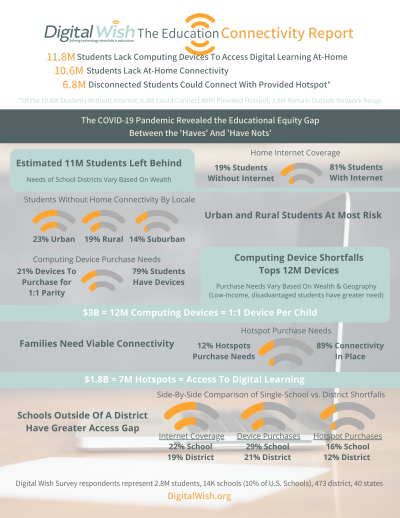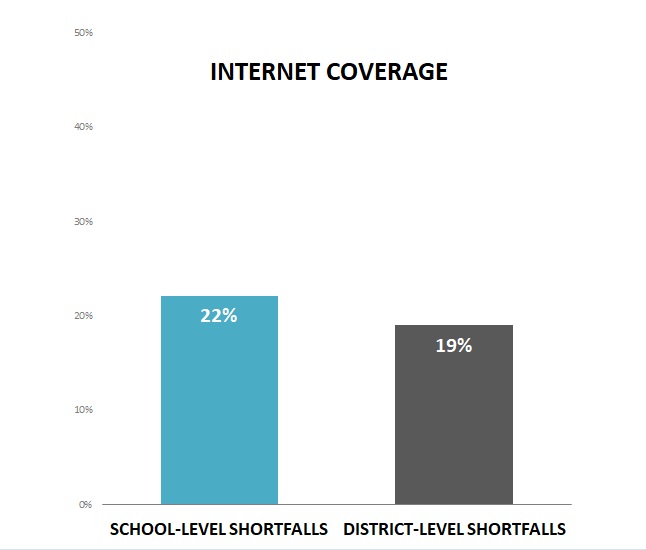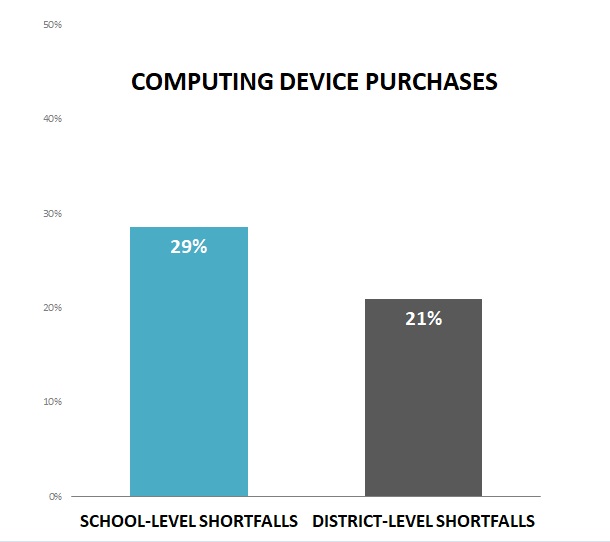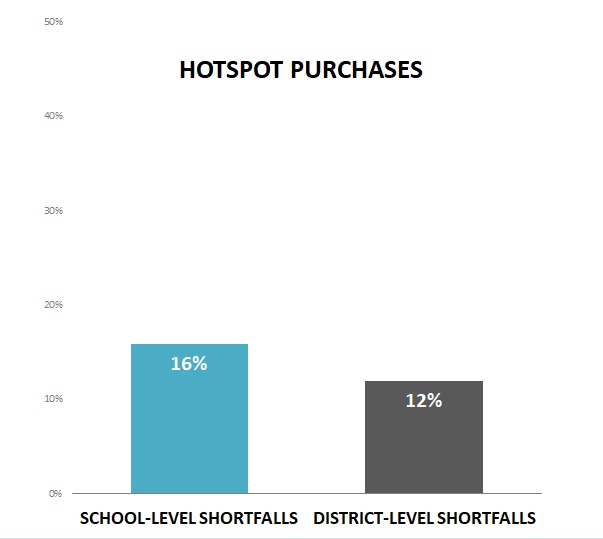Print the Survey Results and Read Stories From the Front Lines
Survey of Frontline Educators Reveals - 10.6M students don't have at-home internet connectivity and 11.8M students don't have the computers necessary to access digital learning at home"Students who have home Internet access in our district are getting a much better educational experience..." According to a new survey conducted by Digital Wish, 19% of students do not have internet connectivity at home, and over 21% do not have access to a computing device, impacting their ability to adequately participate in remote learning while schools are closed due to COVID-19. The COVID-19 pandemic is revealing the educational equity gap between the "haves" and "have nots," and a mosaic of stories have emerged from the front lines. Since March nearly all schools have closed down nationwide. Estimated 11 Million Students are Being Left BehindSchool districts reported an 19% gap in home connectivity leaving an estimated 11 million students isolated and left behind from distance learning. "We are a very rural school in the west central mountains of New Mexico and serve a large Native American population from the Alamo Navajo Reservation. There is little infrastructure here, and low socioeconomic culture. Some students have a phone, a few have internet service, and a few have tablets or computers. One student asked me, "How am I supposed to send this back to you? Smoke signals?" Disparities by Wealth: The raw data reveals a wide disparity in the needs of school districts based on wealth. Our poorer districts are fighting for devices and connectivity, while schools that have solved these problems are facing the challenges of new teaching paradigms.
"Going completely digital is difficult with trying to train teachers on the various pieces of technology and web applications that can be used. Urban and Rural Students are the Most At-RiskEven students that are currently counted as "connected" often can't get enough bandwidth to participate in online classes. With entire families operating from home, daytime internet usage has skyrocketed. Students compete with family members and neighbors, as whole communities increase the load on the broadband infrastructure. "Parents, especially who live in the rural neighborhoods, have inadequate internet speed. Bandwidth cannot handle one, much less multiple, students needing to connect for live, virtual classes. Students have tried using phones for hot spots, but they do not have unlimited data so that was not a sustainable option. Some are attempting to buy more internet (which they can't afford). Even if they can afford it, some cannot get it where they live." Computing Device Shortfalls Tops 12 Million Devices"I don't foresee connectivity happening if it's not funded from outside the district." School district leaders report they need to purchase computing devices for 21.3% of their students in order to provide one device per child. The nation will need to spend $3 billion to provide 12 million computers to address the shortfall of computers assuming each computer costs approximately $250. Of the 12 million computers needed, there is a striking disparity in the needs of school districts based on wealth and geography. "We have received an overwhelming number of phone calls and emails from parents asking for devices. Ninety percent of our students qualify for free and reduced lunch. We cannot continue education at home if we don't have devices and Internet for our lowest-income families." Parents Need Viable Connectivity"We have one family with four children with no internet at home, no computer at home, and they are all attempting to get online learning done using the mother's cell phone." Parents are lending students their personal or work computers and cell phones, for school work to address the shortfall but sharing one device creates a new set of challenges, such as students not getting access to online lessons until the evening hours and managing usage across multiple siblings. "My parents are in tears because they are working full time from home on their computers and do not have a device for their child. By the time they get off from working on their laptop. There's no time to stop and help the student get on for Zoom meetings because they missed it during the day while they were working. Students have anxiety due to not being able to get their work done." Districts Report the Need to Purchase Hotspots for 12% of StudentsWhen asked in the survey how many additional hotspots are needed to connect students who don't have access at home, District educators reported they would need to purchase hotspots for approximately 12% of their students which equates to an immediate nationwide need for nearly 7 million hotspots. Commercial carriers are charging rates of $40-$60+ per month for hotspot connectivity. The lower cost subsidized hotspots and broadband connectivity plans are currently marketed at $260 for a wi-fi hotspot loaded with 12 months of subsidized service. At this inexpensive rate, it will take another $1.6 Billion dollars to meet the current educational demand. Single-School Access Gap is GreaterSingle schools tend to be more rural, and have reported experiencing higher rates of connectivity issues. Here is a side-by-side comparison of school-versus-district shortfalls. Survey MethodologySurvey Details Data current: April 24, 2020 All data is self-reported. Respondents are administrators, technology integrators and teachers, responding to a plea for data from leadership associations such as Digital Wish. 3,648 Survey respondents 2,755,492 (4.9% of the nation's 56.5 million students) accounting for: 473 Districts 40 States 13,811 Schools ( 10% of the nation's 133,000 schools) If a respondent did not fill out the whole survey, their data was excluded. Digital Wish conducted an online survey from April 1 to 22, 2020 asking U.S. school administrators and technology educators on the front lines to report their data on student connectivity and to share their stories. The districts that responded represent 2.8M students from 473 districts across 40 states. The sample is representative of the nation across locale, FRL, and size: the demographic proportions are all within 10% of the nation. The largest discrepancy is for Urban, Middle class, Small districts - they represent only 6% of the sample but 14% of the nation. This is within acceptable range. All data is voluntarily self-reported by educational leaders who are contending with disruptive COVID-19 changes. We confirmed the specific self-reported data fields that could be confirmed, such as student count and students that qualify for Free and Reduced Lunch (FARL), as follows:
Also, we confirmed the other metrics collected are reasonable: students without home internet, additional hotspots needed, additional computing devices needed, and students lacking a computing device. We normalized the metrics and checked the variability across similar districts. The metric with the highest variability is additional computing devices needed -- 25 districts had reported a need between 55% and 89% higher than the median for similar districts. This is reasonable given the sample. About Digital WishDigital Wish is a 501c-3 nonprofit on a mission to solve technology shortfalls in education. Every child deserves a technology-rich education to provide them with the skills necessary to thrive in the global economy. Digital Wish partners with technology providers to distribute free or reduced-cost educational technology such as refurbished laptops, tablets and internet "hotspots" to schools and teachers. Digital Wish manages a community of 64k educators in the US, assisting them with their technology needs through lesson plans, fundraiser campaigns for their "technology wishes" and access to affordable educational technology used in the classroom. Since its inception in 2006, Digital Wish has granted over 31,000 technology wishes to educators worth over $17 Million, and administered grants together with Verizon, Dell, Motorola, Henderson Foundation, and Microsoft. For more information, please visit www.digitalwish.org. About Education SuperHighwayEducation SuperHighway joined the survey project to help validate and analyze the data. EducationSuperHighway was founded in 2012 with the mission of upgrading the Internet access in every public school classroom in America. The organization took on this mission because it believes that digital learning has the potential to provide all students with equal access to educational opportunity and that every school requires high-speed broadband to make that opportunity a reality. EducationSuperHighway is funded by national philanthropic organizations including the Chan Zuckerberg Initiative, the Bill and Melinda Gates Foundation, the Salesforce Foundation, and our mission is supported by governors in all 50 states and America's leading CEOs. Having completed its mission, EducationSuperHighway will sunset August 2020. STORIESFor Interviews: We have educators who are willing to be interviewed. Please call if you need quotes with attribution. Contact: Heather Chirtea Executive Director, Digital Wish 802-379-3000 [email protected] Survey respondents were invited to share stories from their local schools. Here is just a sample of what came in. As one parent said, this is not "home school" it's "crisis school". "Until we find an acceptable solution for our internet connectivity issues, it is pointless to pursue obtaining and issuing 1:1 devices." "We are a small, Title 1 school. We are not 1:1 yet, but are fairly close. We have not been given the go-ahead to issue any devices to students because we aren't 1:1. Our biggest issue is our families are so poor that they cannot afford internet service. Some families do not even have a car to drive to a hot spot so their children can login to do/get school work, and meet with their teachers. We really need to connect with our students right now; their mental and emotional wellbeing is so important!" "We are an alternative High School with around 20% of our population being homeless or foster youth. We have the need for individual hotspots because the students couch surf, some live in cars, tents etc." "We are currently teaching online however some students do not have internet so they are given a paper copy basically are left to learn on their own. It is not right, not fair. Unfortunately generally the students without internet are more than likely in the group who would struggle in a classroom before the pandemic. Our school does not have the funding to provide hotspots so our kids are left on their own. It breaks my heart the inequities in this plan." "We have no idea when all students might be connected." "We have not heard from a third of our students due to a lack of technology." "We ran out of devices to give our students!" "As the Superintendent of Schools, I don't even have access to the internet unless I drive back to work. In a global society, it is rather disheartening that some students never have the opportunity to know how global we are until they leave the area. How ironic is it that a pandemic is more global than access to knowledge, life experiences, cultures, different ethnicities, traditions, religions or various experiences in humanity. I would love to be interviewed about this because until we ALL believe that educating all children is the duty of a society we will never make the advances we need. One of these scholars could very well be the engineer to the cure." One student asks, "When can we go back? I want to be in school." "We don't have internet or computers at home. Just a cell phone." - parent of a child not participating online. "Please, help the little ones who can't help themselves. Receiving an education is a human right. Education is the light in the darkness. Every last child deserves that." "Due to a lack of technology, we are not able to provide enough learning experiences that allow our students to be knowledgeable in using different online learning platforms during this pandemic. " "Packets and text work are not terribly engaging or meaningful without teacher elaboration. There are so many online resources which bring lessons alive." "All students have a device but they are hand-me-downs and the units are 6-8 years old. We repair, on an average, 3-5 a week." "Our students have 1:1 chrome books, but some are in repair and we do not have loaners. Additionally we have been out for what will be 3 weeks tomorrow & I am positive that some students' Chromebooks have been damaged/went faulty in this time period, because this is the reality of what happens in the classrooms. Other students may not have chargers or charger is broken, OR we have students in a foster situation and their chrome book or charger may be stolen. I know we have students who are homeless, or have no power or internet. This all makes my heart hurt." "I have one of my 3 students who is sitting outside at the school during the day so he can have internet access. I'm grateful for the parent's support but feel bad that they are sitting outside in cold, sometimes snowy or rainy, weather. The other 2 are not turning in assignments and I fear that they will not be learning anything due to the difficulty of accessing the material." "Parents, especially who live in the rural neighborhoods, have inadequate internet speed. Bandwidth cannot handle one, much less multiple, students needing to connect for live, virtual classes. Students have tried using phones for hot spots, but they do not have unlimited data so that was not a sustainable option. Some are attempting to buy more internet (which they can't afford). Even if they can afford it, some cannot get it where they live." "We need to give students what they need and deserve so this cycle of poverty and the pipeline to prison can be broken for our kids!" "Since we have gone to 'distance learning,' I have only been able to connect to less than 25% of my students. In my 5th/6th grade mixed class, I had 5 of 28 kids on my last Zoom meeting. It is so frustrating that so many do not have access that so many take for granted. We are a 100% high poverty school! How in the world can we expect them to complete assignments?" "Students do not have the ability to desire to communicate, because the work provided by myself is optional." "Students that do not have laptops or tablets are attempting to do work from smartphones. From phones not all things are accessible and they are not able to complete everything at 100%. They are getting frustrated and tired of trying." "Many of our families have lost their phone service due to inability to pay their phone bills during the pandemic and that was their primary means of internet access." "I have already turned away 4 students and told them the best thing I could offer was allowing them to sit outside the school and use our internet. Our district covers hundreds of square miles, we are 85% poverty and parents don't always have gas and/or time to take their children up to the school." "Not all students have unshared use of a computer at home. Many parents didn't want to take one for each child out of courtesy to someone who is more needy." "A student at the middle school cries because she is unable to keep up with remote learning as a result of poor connectivity at her home. Another student is part of a household that only has one vehicle, and there are no service providers in her area for high speed broadband." "We have had parents tell us they are ordering Chromebooks with plans to return in 30 days because they don't have money for them." "We received a T-Mobile grant at the beginning of this year for mifi's for students. We handed them out and got back most of them as the hotspots did not help. Our students cannot get cell reception in most areas, much less internet connectivity. As this crisis started, we handed them out again and told students and parents to use them when they came into town as they could park in our school parking lot and connect there. Even so, students do not have devices to use. Many attempt to do what they can on smartphones, but even so these are limited. We have one family with four children with no internet at home, no computer at home, and they are all attempting to get online learning done using the mother's cell phone. This is a HUGE issue..." "One of our current hotspots is checked out to a family with five siblings in our district. The first day of online classes, they had used their allotted 1000 MB of data by 10:30 in the morning." Let's make distance learning available to all students, regardless of their wealth or zip code. |
